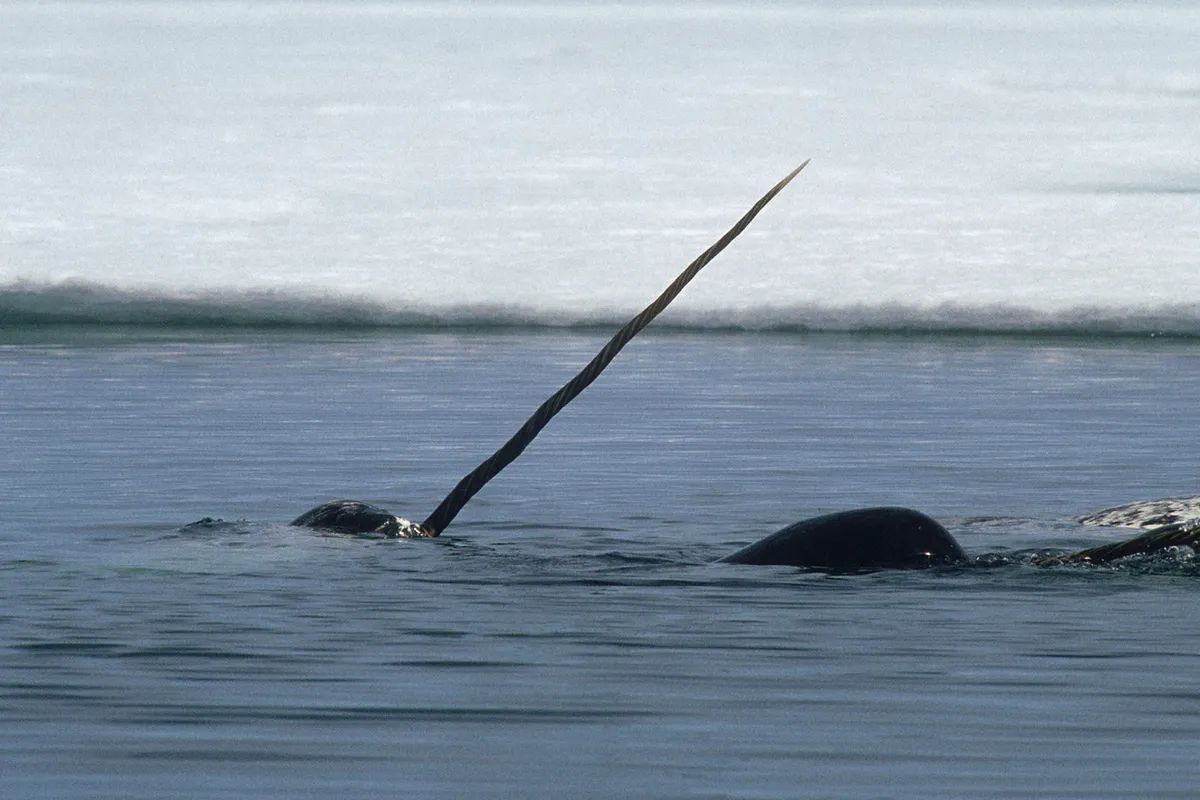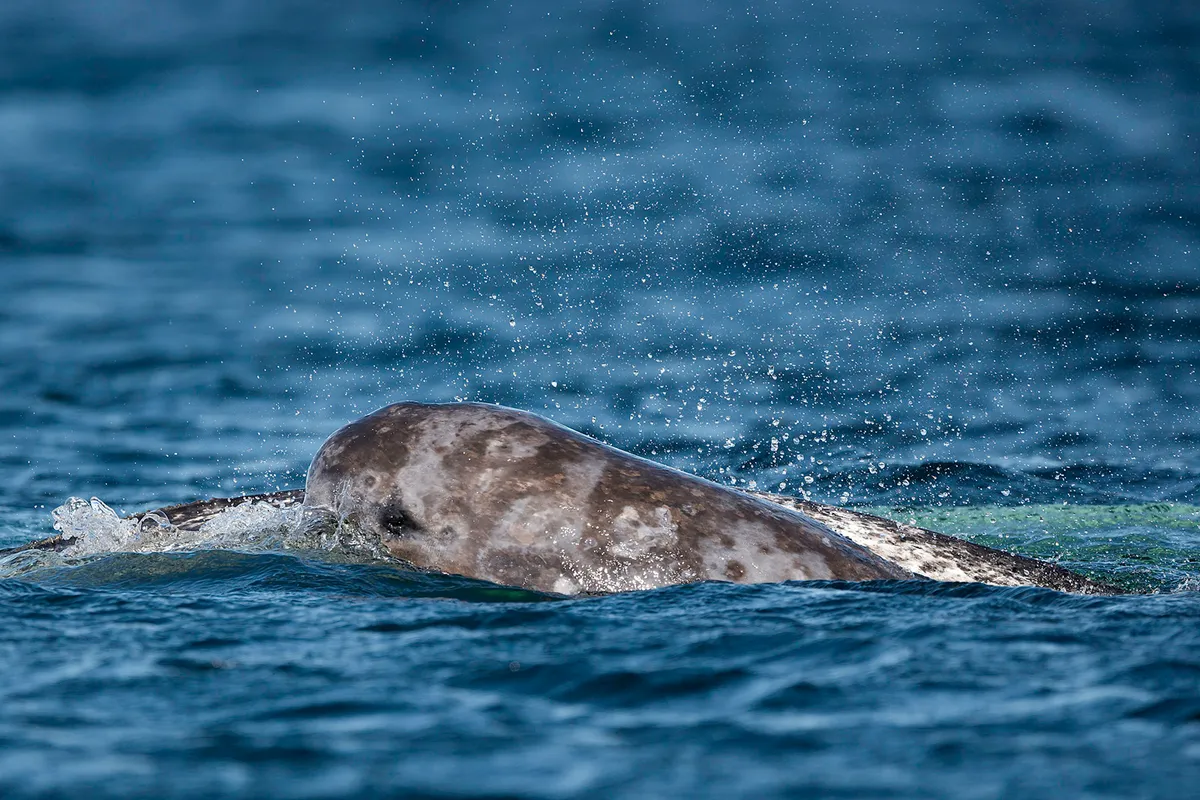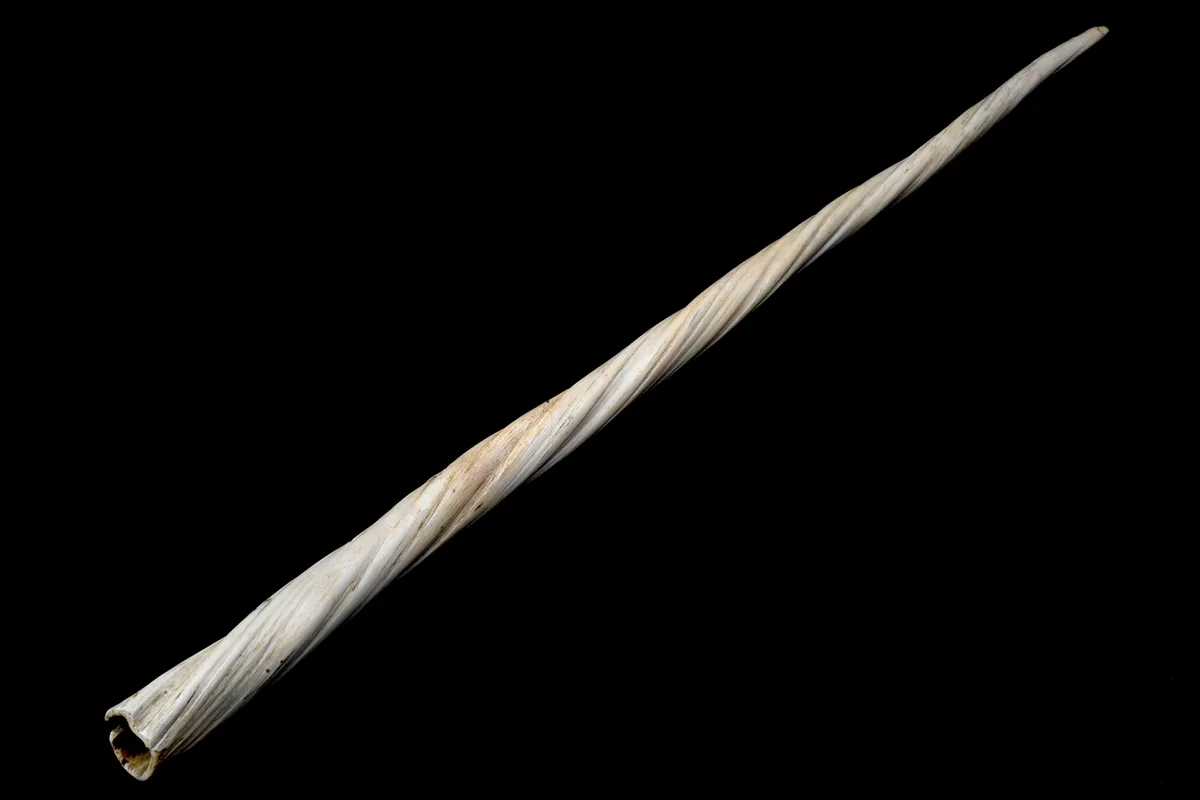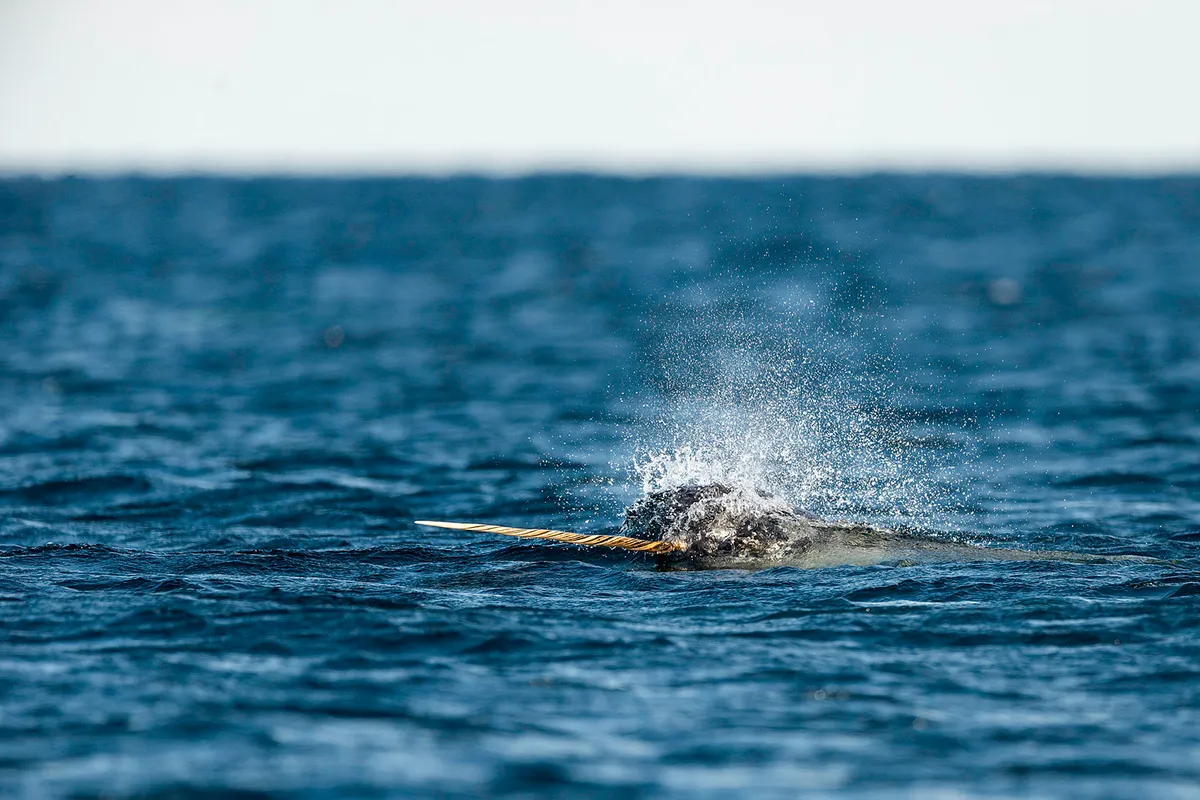Narwhals – also known as the unicorns of the sea for the long tusk that protrudes from the heads of males – are medium-sized toothed whales. Learn about this sociable species in our expert narwhal guide from Whale and Dolphin Conservation. Narwhals feature in BBC One's Frozen Planet II.
What is a narwhal?
A narwhal is a whale living in the Arctic Ocean. Males are easily recognised by their single long tusks, which are actually modified canine teeth. Despite being a toothed whale, the narwhal has no teeth in its mouth. The species travels in pods of around 15-20 whales.
Please note external videos may contain ads:
What is the scientific name of the narwhal?
Monodon monoceros
What is the classification of a narwhal whale?
- Kingdom: Animalia
- Phylum: Chordata
- Class: Mammalia
- Order: Cetartiodactyla
- Family: Monodontidae
- Genus: Monodon
- Species: Monodon monoceros
Why is it called a narwhal?
‘Narwhal’ translates from ancient Norse as ‘corpse-like whale’.
They were given this name because their grey mottled bodies resembled the corpses of drowned sailors.
They are known by Inuits in Greenland as ‘qilalugaq qernartaq’ which means ‘the one that points to the sky’ and their Latin name is Monodon monoceros, meaning ‘one toothed’.
Sometimes referred to as sea unicorn; unicorn whale.
Why are narwhals known as the unicorn of the sea?
Because they look like unicorns! The narwhal inspired many a seafaring legend and their tusks were sold as unicorn horns.
BBC One's Frozen Planet II
Frozen Planet II: Inside the epic new BBC series
Image: Cameraman Alex Vail filming emperor penguin chicks, Atka Bay, Antarctica © BBC Studios/Yoland Bosiger
Are there any subspecies of narwhal?
No but there are thought to be approximately 12 discrete and semi-discrete subpopulations.
What part does a narwhal play in the ecosystem of the oceans?
As other species of cetacean, one of the main roles a narwhal plays in the ecosystem is the recycling nutrients.
Where do narwhals live?
Narwhals are at home in the freezing pack ice of the Arctic, living above the Arctic Circle right up to the polar ice cap.
In the summer they migrate to coastal waters and fjords of Greenland and Canada moving offshore again in winter to avoid being trapped by ice.
What are the physical features of a narwhal?

What sticks out most for males (literally!) is the massive tusk which can grow up to 10 feet long.
Most females don’t have a tusk and they look a bit like mottled grey beluga whales.
Narwhals have a blotchy sausage-shaped body, a rounded head with no beak, a ridge on their backs rather than a fin and short blunt flippers with upcurled edges.
They have odd-shaped tail flukes that look as though they have been put on backwards.
How big is a narwhal?
The male narwhal is larger than the female. Around 4.8m for the male and 4.4m for the female.
Do individual narwhals have distinguishing features?
Individuals have varying notches and nicks in their dorsal ridges and can therefore be identified over time.
How many blow holes does a narwhal have?

The narwhal has a single blow hole.
Toothed whales, of which the narwhal belongs, have one blowhole where as baleen whales have two.
The difference between having one or two is a matter of evolution and adaptation to their environment and size.
Baleen whales have two as this allows them to more efficiently use oxygen when supporting such large bodies.
How long do narwhals live for?
Narwhals can live for around 25 years.
When does the tusk of a narwhal start to grow?
Slowly after birth (not until at least 20 months) – as with other mammalian teeth. The narwhal tusk will be fully grown when they reach maturity.
The tusk can grow unto 10 feet in length.
What is the tusk of a narwhal made of?

The narwhal’s tusk is actually a tooth with millions of nerve endings inside it, meaning they can use it to ‘feel’ or taste.
Narwhals have two teeth and in males, the left tooth usually forms a tusk.
Some males end up with two tusks and about 3% of females grow a tusk.
What is the narwhal's tusk used for?
Quite honestly, we don’t know but theories abound.
Some believe that males use them to attract females, showing off their ‘manliness’ through jousting matches, others have suggested that it’s used as an ice pick or even an acoustic probe.
In 2014 researchers discovered that the tusk is a sensory organ – narwhals can use it to detect changes in the water around them, including temperature.
It is believed that they can ‘taste’ concentrations of salt and perhaps use their tusks to find food or females who are ready to mate.
In 2017, drone footage revealed narwhals stunning fish with their tusk before eating them. It seems the more we discover, the deeper the mystery becomes!
Please note that external videos may contain ads:
Please note that external videos may contain ads:
The first-ever footage of Narwhals using their tusks for feeding | Fisheries and Oceans Canada
What is unique about the narwhal tusk compared to other tusked animals?
They are spiralled. They are teeth – meaning they are made of dentine as opposed to keratin and other proteins.
How large are narwhal pods?

Narwhals live in groups of 10 to 20 individuals but in the summer they come together in groups of hundreds or even thousands of whales to migrate.
They travel together, swimming fast and close to the surface.
The social structure of the narwhal is not really know, as research states that almost anything goes. Pods can be made up of juveniles, males, females, or mixed.
Do narwhals migrate to reproduce?
They will have different breeding and feeding grounds, moving during seasons so as not to be trapped by ice.
How often does the narwhal have young?
The gestation period of a narwhal is 14 months, but they won’t have another calf until this one leaves its mother.
Narwhal births are only single calves.
How large is a narwhal calf at birth?
A narwhal calf measures about 1.5m (10') and weighing 175 lbs. The calf will be completely dependent on the mother for at least 20 months.
How long can a narwhal stay underwater and how deep do they dive?
The narwhal can hold its breath for an amazing 25 minutes.
Narwhals are one of the deepest diving whales. The deepest recorded narwhal dive is 1,500 metres.
Please note that external videos may contain ads:
The Narwhal's Mysterious Tusk | National Geographic
How fast can a narwhal swim?
Approx. 10 knots. But will have bursts of speed, and also slow swimming.
Do narwhals interact with other species of whales?
Yes. There is known to be the existence of a narluga, a beluga/narwhal hybrid, with the female narwhal mating with a male beluga.
The first evidence of a narluga is a skull which is housed in the Natural History Museum of Denmark (NHMD) in Copenhagen.
According to Inuit hunters narluga are grey in colour with a narwhal tail and beluga pectoral fins.
What is the diet of the narwhal?
They like flatfish, cod, shrimp and squid and species like crab that they find on the seabed during their long dives.
They use echolocation to help them find food and have an interesting way of eating –creating a sort of vacuum and sucking up their food.
No one really knows if their tusk plays a role in hunting or feeding.
You may also be interested in:
- Whales, dolphins and porpoises of the UK guide: which species to look out for, how to identify, and where to see them
- First records of orcas seen killing and eating blue whales
- Whale shark guide: what they eat, where they're found and why they're endangered
- Mystery behind whale shark rendezvous solved?
Are narwhals still hunted for their tusks?
Yes - Inuit people in Canada and Greenland kill narwhals for their blubber and tusks.
The main hunting region of East Greenland is Ittoqqortoormiit, when surveys were carried out in 2008 it was estimated that there were about 1900 narwhals in the region. In 2016 it was estimated the population had dropped by nearly 80% to around 400.
As a direct result of hunting, the narwhal population of East Greenland is on the verge of extinction. Despite warnings, the Greenland government still allow hunting.
Does a narwhal have any natural predators?
Their natural predators are polar bears, orcas and sharks and they have been hunted by Inuit for their skin, blubber and tusks for centuries.
How does a narwhal defend itself?

They use body slams and tail slaps but one technique they use is to ‘hide’ – as their biggest predator is the polar bear, which gets them as they come up to breathe, they lie low under the ice.
What is the biggest threat to the narwhal?
Apart from hunting - because they are so adapted to life in the polar ice, they are probably the whale species most affected by climate change, the other being the beluga.
How does plastic pollution affect narwhals?
It doesn’t – yet! Plastic pollution is not a major issue in the far north.
What is the current conservation status of the narwhal?
In 2012 the IUCN conservation status was listed as Near Threatened; In 2017 the IUCN conservation status was listed as Least Concern.
The current population of the narwhal is estimated to between 170,000 and 123,000 mature individuals.
Is the opening of the Northwest Passage a problem for wildlife?
Arctic sea-ice has now retreated to the point that the Northwest Passage, which links the Atlantic and Pacific Oceans via Canada’s northern coast, and the Northern Sea Route, which traverses Arctic Russia, are both open to shipping for at least part of the year, with traffic expected to increase.
Little is known about the biology of Arctic marine mammals in general, so the impacts are difficult to judge, but a survey published in 2018 identified narwhals and walruses as particularly vulnerable to disturbance from boat collisions, noise and developments in infrastructure, especially at bottlenecks such as the Bering Strait, through which both shipping and migratory animals must pass.
This Q&A originally appeared in BBC Wildlife magazine, and was answered by Stuart Blackman
Genome reveals genetic oddity

By sequencing the genome of a narwhal, Danish scientists have discovered that these tusked whales have long-term low genetic diversity.
“Many species have low genetic diversity, but often it is a recent phenomenon, due to a population decline or inbreeding,” says Eline Lorenzen from the Natural History Museum of Denmark.
“What is unique, is that we see this low diversity over the past million years.”
Historically, low genetic diversity has been viewed as a disadvantage because it was thought that when a member of a species has less DNA variation, it would find it difficult to adapt to changes in their surroundings.
“Narwhals may have evolved different mechanisms to cope with their limited genome diversity,” explains co-author Michael Westbury.
Despite this discovery, narwhal populations have a large global abundance, which most likely reflects a recent rapid expansion from a much smaller founding population.
There are currently about 170,000 individuals, resulting in the IUCN downgrading the species’ conservation status from Near Threatened to Least Concern.
“The reason the narwhal is still alive today may be because it had ample time to adjust in the past,” says Westbury.
“However, the rapid onset of climatic and environmental change induced by mankind may prevent it from being able to do so this time.”
Read the scientific paper: iScience
Originally appeared in BBC Wildlife magazine, and was written by Lewis White
Please note that external videos may contain ads:
Narwhals | World's Weirdest | Nat Geo WILD
Main image: View of the eye of a narwhal as it comes up to breath, Baffin Island, Canada. © by wildestanimal/Getty
